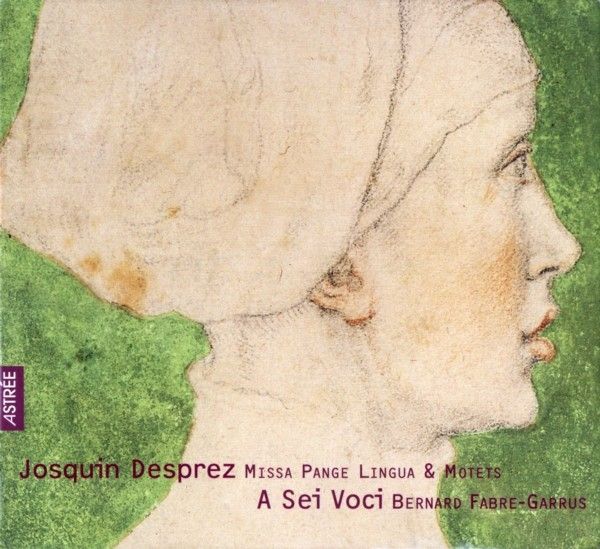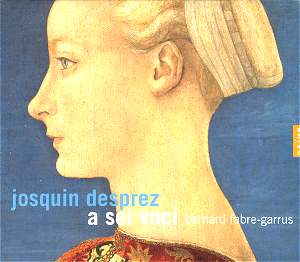
medieval.org
amazon.com
arkivmusic.com
Astrée (Naïve) E 8639
April 1999
Church of Saint Robert, Corrèze

medieval.org
amazon.com
arkivmusic.com
Astrée (Naïve) E 8639
April 1999
Church of Saint Robert, Corrèze
Missa Pange lingua, à 4
01 - Appel (bells) [0:31]
02 - Pange lingua (plainchant) [3:52]
03 - Kyrie [3:06]
04 - Gloria [4:34]
05 - Graduel. Christus factus est (plainchant) [2:26]
06 - Credo [7:30]
07 - Sanctus [7:13]
08 - Agnus Dei [7:02]
09 - Popule meus (plainchant) [5:39]
Motets
10 - Qui velatus facie fuisti, à 4 [11:30]
11 - O Domine, Jesu Christe, à 4 [10:25]
12 - Christus mortuus est, à 6 (attr.) [2:19]
13 - Nos autem (plainchant) [3:24]
A Sei Voci
Raoul Le Chenadec, haute-contre
Thierry Brehu, Serge Goubioud, Lucien Kandel, Nicolas Maire, Eric
Raffard, ténors
James Gowings, Jean-Louis Georgel, Jean-Louis Paya, basses
Maîtrise des Pays de Loire
Pascaline Baguenier, Quentin Boucherie, Vanessa Berrué,
Emmanuelle Bouyer, Céline Delanoe, Ludovic Grandière,
Anne Lafhille, Flore Lenoir, Gwenola Maheux, Audrey Payet,
Matthieu Roger, Thomas Roger, Mélaine Vignal
direction of chant: Bertrand Lemaire
Bernard Fabre-Garrus
Compilado en:
Renaissance. Astrée (Naïve) · 4 CDs
http://www.medieval.org/emfaq/cds/ast8871.htm
y en:

musicweb-international.com
amazon.co.uk
The Missa Pange Lingua is believed to be Josquin's last setting, and
has become his most popular today. It is, in many ways, his closest to
the plainchant on which it is based, showing less artifice than some
settings and a general gravity. It is overwhelmingly in four parts,
with some duet sections which have become justifiably famous. The
overall emphasis on homophonic texture rather than more freely ranging
polyphony also serves to make this mass evocative of the later
developments of Palestrina et al.
The present notes suggest that Josquin's real family name may have been
Lebloitte, an interesting suggestion, and certainly one reason we tend
to favor the "Josquin" name in designating the composer. Track #12 is a
questionable attribution.
This recordings marks the fifth in a planned complete cycle of
Josquin's masses by the present ensemble. One notable feature of the
cycle is that different issues have featured different supporting casts
and consequently sonorities.